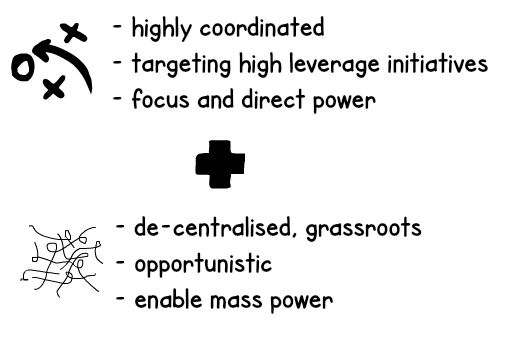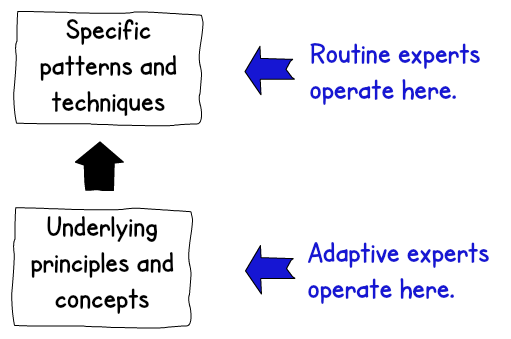My preferred models and strategies for facilitating large-scale change
Simultaneous “air and ground war” (but it’s mostly a “ground war”)
The “air war” is establishing and controlling a narrative through inspirational speeches, videos, education sessions, etc. Essentially propaganda.

The “ground war” is influencing person-by-person but also, more importantly, modifying policies and systems.

Many, if not most, people assume change is just an air war and are surprised when they control the narrative and yet nothing actually changes. The goal is not to change stories and symbols. The goal is not even to change minds. The goal is to change behavior.
Controlling narrative is useful only inasmuch as it provides cover to enable policy and system change, which in turn enables behaviour change.
Reference: Scaling Up Excellence
Simultaneous coordinated and opportunistic change strategies (but if I can’t do both, I’ll choose coordinated)
I generally like having two general change strategies happening simultaneously.

The first strategy is highly coordinated, targeting high leverage initiatives. The second strategy is de-centralised, grassroots, and opportunistic.
The first strategy is intended to create a significant impact, faster, while the second strategy is intended to create long-term engagement and innovation.
The first strategy is about focusing and directing power while the second strategy is about enabling mass power.
If I can’t do both, I will choose a targeted change strategy over a mass change strategy.
Think like a Commander
When you expose apparent experts to unanticipated situations, you’ll notice that some experts will fail to perform while others still thrive.
The reason for this is that adaptive experts actually think differently about situations. Whereas the routine expert is thinking about specific patterns and techniques that may not survive context changes, the adaptive expert is using a deep understanding of underlying principles and concepts. The routine situation doesn’t expose this difference but the unanticipated situation does.

The US Army noticed this phenomenon with their tactical commanders and developed a program called Think Like a Commander in order to teach cognitive themes for adaptive tactical decision-making. I’ll adapt this for how to think about large-scale change.
- Keep a focus on mission and higher intent. This is not just what you are trying to change but what are broader and larger relevant goals;
- Model thinking participants. Even if you are seeking what you believe is a mutually beneficial outcome, the other participants in your change are intelligent, have their own motivations, and their own strategies;
- Consider the effects of terrain, that is organisational and environmental structure and context;
- Use all assets available. Assets include pre-existing skills and experiences, past case studies, pre-existing structures, processes, policies, tools, etc.;
- Include considerations of timing. What are the timing constraints? What is the cost of delaying impact?
- Consider where your change fits into the bigger picture of what is happening. What are other changes and activities happening in the larger context? Consider both “friendly” and “non-friendly” perspectives;
- Exhibit visualisations that are dynamic, proactive, and flexible. Large-scale change is complicated. Use visual models to externalize your thinking and enable others to participate;
- Show rich contingency thinking. What can go wrong? How will you avoid, mitigate, transfer, or accept?
Reference: Think Like a Commander
Role models, systems, symbols
According to Systems Leadership, there are three basic tools to change behaviour: role modelling, systems, symbols.

Role modeling
Role modeling, especially by influential, powerful people, tells everyone else what is considered acceptable. If role models break rules and there are no consequences, it tells everyone else that those weren’t the real rules. If role models follow rules that are unstated, it tells everyone else that these hidden rules are the real rules. If role models break rules that no one else is allowed to, it tells everyone else that the only rule is power.
Systems
Systems are about structure, processes, and policies. If systems are not reinforcing desired behaviour, then the behaviour will not last. Even role models are not as ever-present as systems.
Symbols
Symbols are a concrete representation of the story we tell ourselves about how things work. Symbols are useful when they are congruent with role models and systems; symbols trigger cynicism when they are incongruent with role models and systems. In other words, hypocritical symbols are worse than useless.
Reference: Systems Leadership
Six sources of influence
The Fundamental Attribution Error refers to the tendency for people to overemphasise dispositional and personality explanations for behaviour and underemphasise situational explanations.
To address this, I like using the Six Sources of Influence model from VitalSmarts.

- Personal Motivation: what the individual wants
- Personal Ability: what the individual knows how to do
- Social Motivation: what friends, family, colleagues want the individual to do
- Social Ability: what friends, family, colleagues can help the individual do
- Structural Motivation: what incentives exist in the environment
- Structural Ability: what is easy or not easy to do in the environment
Instead of just considering motivation, we should also consider ability; instead of just considering the individual, we should also consider the social and the structural.
The more of sources of influence are in play, the more likely behaviour change will occur.
The best approach for high probability, persistent behaviour change is not “we just need to change their thinking” nor “we just need to make the right thing easy to do” but rather as many sources of influence as you can affect.
Reference: Influencer
Change systems and behaviour to change mindset; not vice versa
A common mistake with large-scale change is to start by trying to change what people believe (aka “change the culture”), with the idea that this will eventually lead to behaviour change.
Starting by trying to change what people believe is yet another example of Fundamental Attribution Error. Individual beliefs are not the only, and likely not even the most significant, reason why people behave in a particular way.
It’s more effective to change what people do and allow that to change what they believe. Changing what people do means:
- every policy and communication very consistently says “this is what is expected”;
- training and tooling is provided that makes desired behaviour easier to do and undesired behaviour harder to do;
- every manager and influential role model is consistently demonstrating the desired behaviour and is readily available to help other people do it.
Over time, consistent behaviour changes what people believe is truly valued and therefore what is culturally expected.
This is what is meant by “It’s easier to act your way into a new way of thinking than to think your way into a new way of acting.”

Reference: How to Change a Culture: Lessons from NUMMI
Start with non-controversial problems; use visibility and reframing to make controversial problems non-controversial
I generally prefer to start with non-controversial problems because they are less likely to get bogged down, and therefore more likely to create momentum.
Once there is momentum, subsequent improvements are easier, including with normally controversial problems.

I generally don’t like grand schemes because they are both more difficult to setup, and more likely to be controversial, which is more likely to stall progress.
Instead, for controversial, big problems, I prefer to improve visibility and reframe to make them non-controversial first, and breaking them down so they no longer require grand schemes.

When nothing else seems to be working, look for exceptions (OR start there)
When nothing else seems to be working, it is useful to remind yourself that no problem is perfect. There is always an exception to provide insight into a path for improvement.

Reference: Positive Deviance
